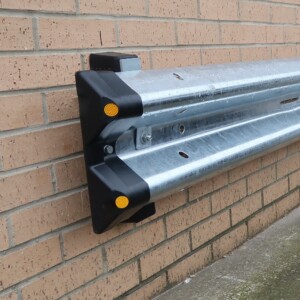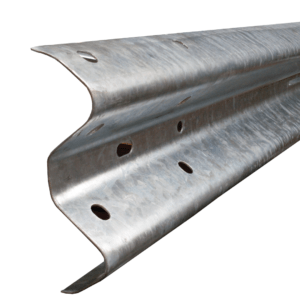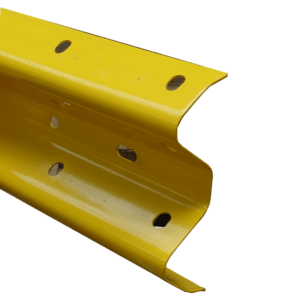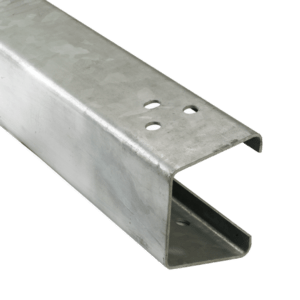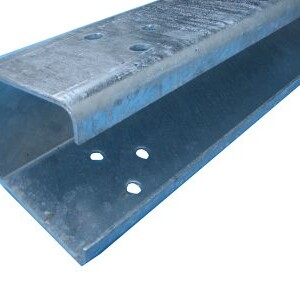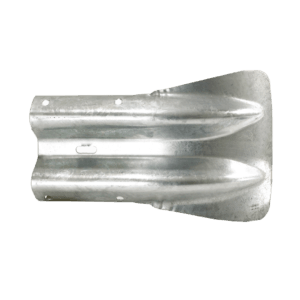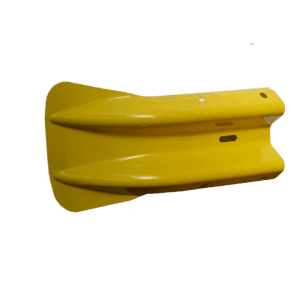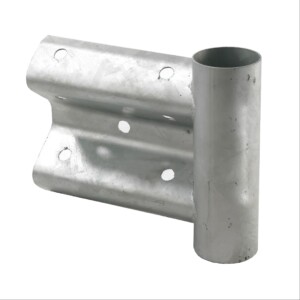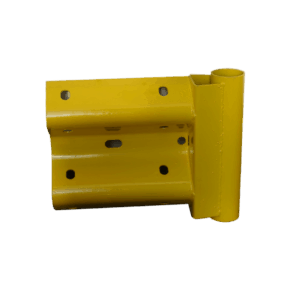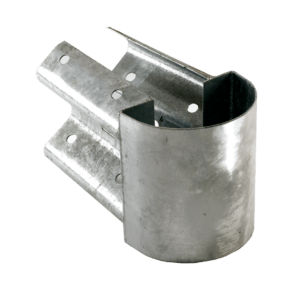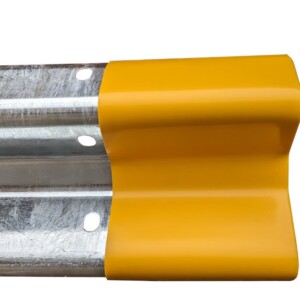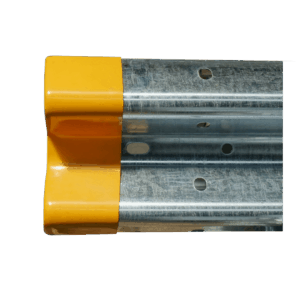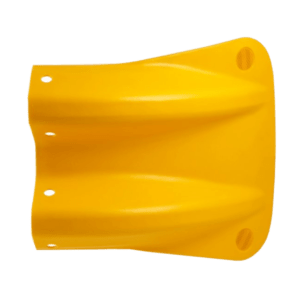Armco Crash Barrier
Armco Crash Barrier Ends are a means of restraining an errant moving vehicle, generally by the use of a horizontal beam mounted on vertical posts.
Armco Crash Barriers: Protecting Lives and Property
Armco crash barriers, sometimes referred to as guardrails or safety barriers, serve a pivotal role in preserving the safety of both motorists and pedestrians. They are engineered to deliver protection against grave accidents and injuries. These road safety implements are typically constructed of an assembly of steel beams that are bolted together. Their design aims to present a robust and flexible barrier capable of absorbing the powerful impact of a vehicular collision, thereby safeguarding the people and objects that lie beyond them.
The usage of Armco crash barriers stretches back more than half a century. Their purpose is to inhibit vehicles from veering off the road, thereby mitigating the risk of collisions with potentially dangerous obstacles like trees, buildings, and even other vehicles. These barriers have become a common sight in various environments, including but not limited to highways, rural roads, and urban regions. They are frequently installed in locations identified as high risk, such as near dangerous curves, steep slopes, bridges, or any areas where there is a sudden change in road conditions.
One cannot underestimate the myriad benefits associated with Armco crash barriers. The first and foremost is their ability to dramatically reduce the risk of fatalities and serious injuries in the event of a crash. When a vehicle impacts the barrier, the kinetic energy is diffused along the barrier’s length, reducing the force experienced by vehicle occupants. Furthermore, they serve as a shield for property and infrastructure, preventing damage from wayward vehicles. They also decrease the probability of significant traffic disruptions resulting from accidents, contributing to overall smoother traffic flow.
Moreover, Armco crash barriers demonstrate exceptional versatility. They can be adapted and customized to suit the unique requirements of specific locations and environments. Available in an array of shapes and sizes, they cater to various traffic situations and road layouts. The materials used in their construction can vary as well, ranging from steel to aluminum and concrete, each chosen according to specific needs and circumstances.
In addition to serving as a protective function, Armco crash barriers play an instrumental role in traffic guidance and road safety enhancement. By creating a clear delineation between opposing lanes of traffic, they help reduce instances of head-on collisions. Furthermore, by establishing a buffer zone between vehicles and pedestrians, these barriers contribute to preventing accidents before they even occur. Their reflective markers also assist drivers in discerning road alignments, especially during adverse weather conditions or at night.
To sum up, Armco crash barriers are an indispensable part of modern road infrastructure, acting as a safety net in our complex transportation networks. They provide a critical layer of protection for motorists, pedestrians, and property alike. By absorbing the energy of impacts, preventing vehicles from leaving the roadway, and providing visible cues to drivers, they significantly contribute to the prevention of accidents. They help to ensure the safe and efficient transit of people and goods on our roads and highways, fostering a secure environment for all road users.
In conclusion, Armco crash barriers represent a fundamental cornerstone of road safety measures in our contemporary society. Their vital role in preserving lives and infrastructure and promoting efficient traffic flow attests to their irreplaceable value. As our transportation networks continue to grow and evolve, it is crucial that we continue to invest in and innovate these protective measures to enhance their effectiveness and adaptability in the face of new road safety challenges.
Armco crash barriers, also known as guardrails, are designed to protect motorists and pedestrians from serious accidents and injuries. These barriers consist of a series of steel beams that are bolted together to create a strong and flexible barrier that can absorb the impact of a collision.
Armco crash barriers have been used for over 50 years to prevent vehicles from leaving the roadway and crashing into obstacles such as trees, buildings, and other vehicles. They are commonly found along highways, rural roads, and urban areas, and are often installed near dangerous curves, steep slopes, and bridges.
The benefits of Armco crash barriers are numerous. They can reduce the risk of fatalities and serious injuries in the event of a crash, protect property and infrastructure from damage, and minimize the likelihood of traffic disruptions due to accidents.
Armco crash barriers are also highly adaptable and can be customized to fit the needs of specific locations and environments. They come in a variety of shapes, sizes, and materials, including steel, aluminum, and concrete.
In addition to their protective function, Armco crash barriers can also be used to guide traffic and improve road safety. By providing a clear separation between opposing traffic lanes and creating a buffer zone between vehicles and pedestrians, Armco crash barriers can help prevent accidents before they occur.
Overall, Armco crash barriers are an essential component of modern road infrastructure. They provide a critical layer of protection for motorists, pedestrians, and property, and help to ensure the safe and efficient movement of people and goods on our roads and highways.
- Historical Evolution:
Armco crash barriers, tracing their roots to the mid-20th century, represent a milestone in the evolution of road safety infrastructure. Originally conceived as rudimentary guardrails to prevent vehicles from veering off roadways, these barriers have undergone significant technological advancements over the decades. What began as simple steel beams has evolved into sophisticated systems engineered to withstand high-velocity impacts while minimizing collateral damage. The evolution of Armco barriers mirrors the ongoing efforts to enhance road safety standards and adapt to evolving transportation needs.
- Material Innovation:
The effectiveness of Armco crash barriers is closely tied to advancements in materials science and engineering. While traditional steel remains a staple due to its strength and durability, modern barriers increasingly incorporate composite materials and alloys designed to offer superior performance. Aluminum alloys, for instance, provide a lightweight yet robust alternative, ideal for installations where weight restrictions or corrosion resistance are paramount. Moreover, composite materials offer a versatile solution, combining the strength of traditional materials with enhanced flexibility and impact absorption capabilities. By leveraging these innovations, engineers can tailor barrier designs to specific environmental conditions, ensuring optimal performance and longevity.
- Dynamic Deployment Strategies:
The deployment of Armco crash barriers is not a one-size-fits-all endeavor but rather a dynamic process guided by rigorous risk assessment and traffic engineering principles. Transportation authorities employ sophisticated modeling techniques to identify high-risk areas and prioritize barrier installations accordingly. Factors such as traffic volume, vehicle speed, roadside geometry, and accident history are meticulously analyzed to determine the most effective barrier configurations. Moreover, advancements in predictive analytics and real-time monitoring enable proactive maintenance and upgrades, ensuring that barriers remain effective in mitigating emerging risks and evolving traffic patterns.
- Integration with Smart Technologies:
In an era of smart infrastructure, Armco crash barriers are embracing technology to enhance their efficacy and responsiveness. Integrated sensor networks and IoT-enabled devices allow barriers to detect and communicate critical information in real-time. For instance, sensors embedded within barriers can detect impacts and automatically alert authorities, enabling swift emergency response and proactive maintenance. Additionally, advanced telematics systems provide insights into barrier performance and traffic patterns, empowering decision-makers to optimize infrastructure investments and improve overall road safety.
- Global Impact and Adoption:
The impact of Armco crash barriers extends far beyond national borders, with their adoption proliferating across continents and diverse transportation landscapes. From densely populated urban corridors to remote rural highways, these barriers serve as universal symbols of safety and resilience. International collaborations and knowledge-sharing initiatives have facilitated the exchange of best practices and standards, fostering a global community dedicated to advancing road safety. As emerging economies invest in expanding their transportation networks, Armco barriers play a pivotal role in shaping sustainable infrastructure development and mitigating the human toll of traffic accidents.
By embracing innovation, collaboration, and data-driven decision-making, Armco crash barriers continue to evolve as indispensable guardians of road safety, protecting lives and infrastructure in an increasingly complex and interconnected world.
- Environmental Considerations:
In addition to their primary function of enhancing road safety, Armco crash barriers are increasingly designed with environmental sustainability in mind. Manufacturers are exploring eco-friendly materials and production processes to minimize the carbon footprint of barrier production and installation. Recycled steel and composite materials sourced from renewable sources offer viable alternatives to conventional materials, reducing reliance on finite resources and mitigating environmental impact. Furthermore, barrier designs are optimized to minimize disruption to natural habitats and ecosystems, ensuring harmonious coexistence with the surrounding environment.
- Human-Centered Design:
Human factors play a pivotal role in the design and placement of Armco crash barriers, with a focus on maximizing user safety and comfort. Barrier heights, profiles, and visibility features are carefully calibrated to optimize driver awareness and responsiveness, reducing the likelihood of collisions and improving overall road user experience. Moreover, considerations for vulnerable road users, such as pedestrians and cyclists, inform barrier designs to minimize the risk of secondary accidents and enhance inclusivity. By prioritizing human-centered design principles, Armco barriers foster a safer, more intuitive road environment for all users.
- Lifecycle Management and Recycling:
Sustainable lifecycle management practices are integral to the continued effectiveness and environmental stewardship of Armco crash barriers. Beyond installation, proactive maintenance and periodic inspections ensure barrier integrity and performance over their operational lifespan. End-of-life considerations are also addressed through comprehensive recycling programs, where retired barriers are responsibly dismantled and processed to recover valuable materials for reuse. By closing the loop on materials management, these programs minimize waste generation and conserve natural resources, contributing to a circular economy ethos within the transportation sector.
- Community Engagement and Education:
Effective road safety initiatives involving Armco crash barriers extend beyond physical infrastructure to encompass community engagement and education programs. Stakeholder outreach efforts raise awareness about the importance of safe driving practices and the role of barriers in mitigating road risks. Educational campaigns targeting motorists, pedestrians, and schoolchildren provide valuable insights into traffic safety norms and empower individuals to make informed decisions on the road. Furthermore, interactive workshops and public demonstrations showcase the science and engineering behind barrier design, fostering a culture of safety-conscious behavior and collective responsibility.
- Future Trends and Innovations:
Looking ahead, the future of Armco crash barriers is shaped by ongoing technological advancements and emerging trends in mobility. Innovations such as self-repairing materials, adaptive barrier systems, and automated crash avoidance technologies hold promise for further enhancing barrier effectiveness and responsiveness. Moreover, the integration of artificial intelligence and predictive analytics enables proactive risk mitigation strategies, where barriers dynamically adapt to changing traffic conditions and environmental factors in real-time. By embracing these trends, Armco barriers remain at the forefront of road safety innovation, poised to address evolving challenges and safeguard lives in an ever-changing transportation landscape.
Showing 1–16 of 40 results

